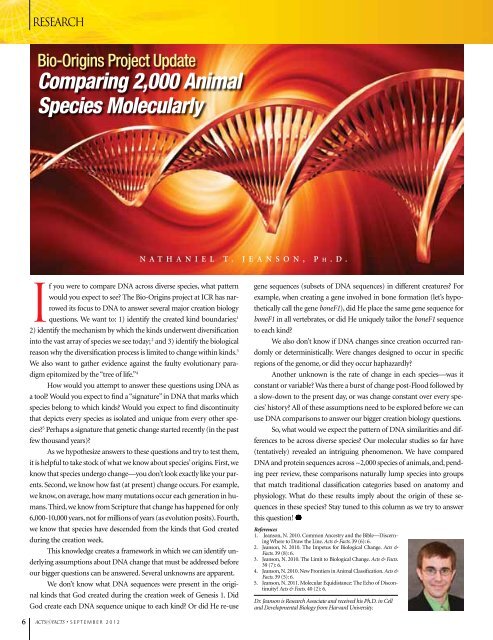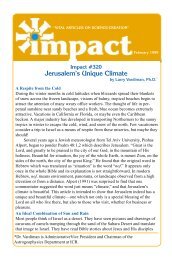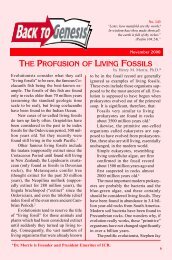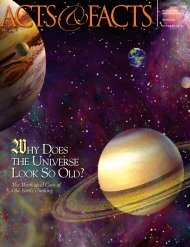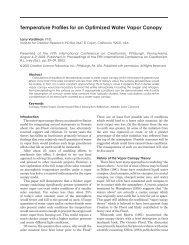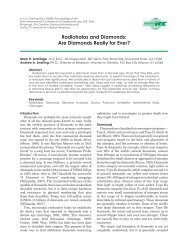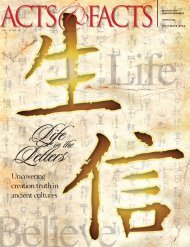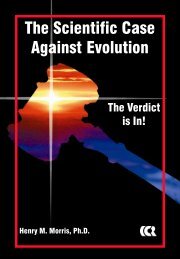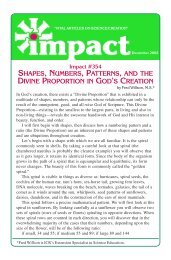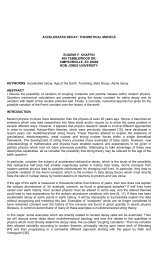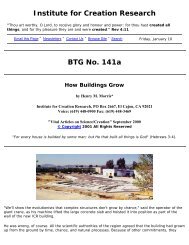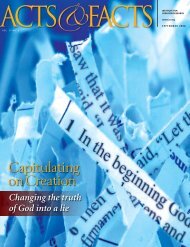Acts & Facts - Institute for Creation Research
Acts & Facts - Institute for Creation Research
Acts & Facts - Institute for Creation Research
Create successful ePaper yourself
Turn your PDF publications into a flip-book with our unique Google optimized e-Paper software.
RESEARCHBio-Origins Project UpdateComparing 2,000 AnimalSpecies MolecularlyN a t h a n i e l T . J e a n s o n , P h .D.If you were to compare DNA across diverse species, what patternwould you expect to see? The Bio-Origins project at ICR has narrowedits focus to DNA to answer several major creation biologyquestions. We want to: 1) identify the created kind boundaries; 12) identify the mechanism by which the kinds underwent diversificationinto the vast array of species we see today; 2 and 3) identify the biologicalreason why the diversification process is limited to change within kinds. 3We also want to gather evidence against the faulty evolutionary paradigmepitomized by the “tree of life.” 4How would you attempt to answer these questions using DNA asa tool? Would you expect to find a “signature” in DNA that marks whichspecies belong to which kinds? Would you expect to find discontinuitythat depicts every species as isolated and unique from every other species?5 Perhaps a signature that genetic change started recently (in the pastfew thousand years)?As we hypothesize answers to these questions and try to test them,it is helpful to take stock of what we know about species’ origins. First, weknow that species undergo change—you don’t look exactly like your parents.Second, we know how fast (at present) change occurs. For example,we know, on average, how many mutations occur each generation in humans.Third, we know from Scripture that change has happened <strong>for</strong> only6,000-10,000 years, not <strong>for</strong> millions of years (as evolution posits). Fourth,we know that species have descended from the kinds that God createdduring the creation week.This knowledge creates a framework in which we can identify underlyingassumptions about DNA change that must be addressed be<strong>for</strong>eour bigger questions can be answered. Several unknowns are apparent.We don’t know what DNA sequences were present in the originalkinds that God created during the creation week of Genesis 1. DidGod create each DNA sequence unique to each kind? Or did He re-usegene sequences (subsets of DNA sequences) in different creatures? Forexample, when creating a gene involved in bone <strong>for</strong>mation (let’s hypotheticallycall the gene boneF1), did He place the same gene sequence <strong>for</strong>boneF1 in all vertebrates, or did He uniquely tailor the boneF1 sequenceto each kind?We also don’t know if DNA changes since creation occurred randomlyor deterministically. Were changes designed to occur in specificregions of the genome, or did they occur haphazardly?Another unknown is the rate of change in each species—was itconstant or variable? Was there a burst of change post-Flood followed bya slow-down to the present day, or was change constant over every species’history? All of these assumptions need to be explored be<strong>for</strong>e we canuse DNA comparisons to answer our bigger creation biology questions.So, what would we expect the pattern of DNA similarities and differencesto be across diverse species? Our molecular studies so far have(tentatively) revealed an intriguing phenomenon. We have comparedDNA and protein sequences across ~2,000 species of animals, and, pendingpeer review, these comparisons naturally lump species into groupsthat match traditional classification categories based on anatomy andphysiology. What do these results imply about the origin of these sequencesin these species? Stay tuned to this column as we try to answerthis question!References1. Jeanson, N. 2010. Common Ancestry and the Bible—DiscerningWhere to Draw the Line. <strong>Acts</strong> & <strong>Facts</strong>. 39 (6): 6.2. Jeanson, N. 2010. The Impetus <strong>for</strong> Biological Change. <strong>Acts</strong> &<strong>Facts</strong>. 39 (8): 6.3. Jeanson, N. 2010. The Limit to Biological Change. <strong>Acts</strong> & <strong>Facts</strong>.39 (7): 6.4. Jeanson, N. 2010. New Frontiers in Animal Classification. <strong>Acts</strong> &<strong>Facts</strong>. 39 (5): 6.5. Jeanson, N. 2011. Molecular Equidistance: The Echo of Discontinuity?<strong>Acts</strong> & <strong>Facts</strong>. 40 (2): 6.Dr. Jeanson is <strong>Research</strong> Associate and received his Ph.D. in Celland Developmental Biology from Harvard University.6 ACTS&FACTS • SEPTEMBER 2012


